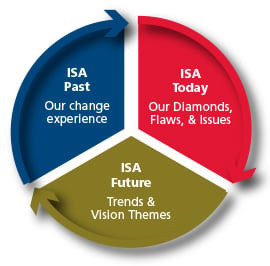This post is authored by Peggie Koon, president of ISA 2014.
As I mentioned in last month’s article, one of our key goals this year is related to making sure that the Society – especially its leadership – is laser-focused on strategy. We are committed to developing strategic processes to help us identify strategic initiatives that will enhance the ISA value proposition, increase brand awareness, enhance our products and services and/or result in new revenue streams. To start the process Society  leaders convened for their first Executive Summit of 2014 – “ISA’s Future Search & Focus” – in Greensboro, N.C.
leaders convened for their first Executive Summit of 2014 – “ISA’s Future Search & Focus” – in Greensboro, N.C.
During the Summit, Billy Bennett, CEO of Pyramid ODI, led us through a well-planned group of facilitated sessions focused on setting the future direction of ISA based on industry trends, economic indicators, and overall organizational strength. We were also very fortunate to have had Nelson Norden, “strategic sage” at Emerson Automation Solutions, participate and assist in the pre-planning and development effort for the meeting.
Why the Summit was important…
According to Ken Blanchard and Mark Miller in their book, The Secret, great leaders…“must be willing and able to see the future. They must help the people they lead see the destination as well as the advantages of going there…Everybody needs to see who they are, where they are going, and what will guide their journey.” ISA’s Future Search & Focus Executive Summit did just that!
We learned about the past and envisioned ISA’s future…
http://youtu.be/Xe2_91Z_qhQ&w=560&h=350
Billy Bennett’s process led us through a deep dive into our past and how we make change.
 The sessions helped us understand how we have been shaped by our past, who we are today, our diamonds, flaws, and issues, and how we must change for the future.
The sessions helped us understand how we have been shaped by our past, who we are today, our diamonds, flaws, and issues, and how we must change for the future.
In case you’re wondering, Billy Bennett helped us to identify the following:
- Diamonds – Assets we have now that we would carry into our future because they are just too valuable to lose. Leaders identified these assets as our 70 years of intellectual property, our brand, the networking that we provide, the Automation Federation (AF), global diversity, a caring and talented staff, passionate volunteers, the professional and leadership development opportunities we provide, and more.
- Flaws – Things that we do or are engaged in that are barriers to our success. Society leaders discussed how ISA’s investment portfolio influences discussions and the urgency with which we make decisions. Highlighted flaws include: we do not share a unified vision and focus; we also lack the ability to attract the next generation of ISA leader; we no longer have the deep connection we once had with the automation community; and we have a trust gap – among others.
- Issues – Challenges that were deemed to be beyond the scope of the Summit. The issues leaders identified fall into categories that affect how we operate, collaborate, and innovate. If you recall, I mentioned these three areas as being critical pillars on which successful companies stand. Leaders talked openly about concerns they have with governance, interactions with other organizations (e.g., AF and its member organizations), how we embrace technology to facilitate engagement, and how we innovate. We asked some hard questions like: Are we member, product, or customer focused? Is our revenue model sustainable? etc. It is important for us to acknowledge that these issues exist but also to realize that resolving these issues will require an on-going conversation and a willingness to constantly evolve and change.
This first part of the Summit was so unifying and liberating because leaders embraced as a group our past and our present. At the end of these sessions we all had the same very clear understanding of how our past contributes to who we are today. And we could also see collectively some of the changes we must make to move forward into our future.
Envisioning ISA 2019…
In my previous article I said that ISA’s future is bright and is filled with opportunity and summit results validated my belief. The last two sessions of the Summit focused on helping us to look at that future. We began with an exercise during which we developed trend “rivers” impacting ISA. We discussed how we might take advantage of the trends and created a strategic vision statement for the future:
ISA will be the premier Society for automation by serving the needs of the entire automation professional community.
From this vision statement we developed a list of strategic game changers or themes.
Measuring Success…
Our success will be indicated by growth in audience (membership and users) and lowering in the average age of our membership, reflecting a younger average age more representative of automation professionals today.
Developing the Plan: How Vision becomes our Future Reality…
We will do this by emphasizing five strategic game changing themes…
- DATA – To align ISA with markets
- CONTENT DELIVERY – To the career development and opportunity needs of the automation professional
- COOLEST DELIVERY – To connect people and knowledge
- GLOBAL AUTHORITY – On control system cybersecurity
- ADVOCACY – Cradle to grave awareness and proficiency of automation as a career
Next Steps…
If you recall, I’ve said all along our Society needs to move from discussion to action. After a powerful shale gas case study presented by Nelson Norden, we identified two groups of leaders who will begin investigating potential for ISA in two of these game changing areas: cybersecurity and workforce development for the "shale gale" opportunity. We identified two leaders as primary POCs for these opportunities respectively. Both of these leaders will be working with their teams and Nelson Norden to complete the business opportunity analysis associated with each initiative.
And there are two other initiatives related to leader training and readiness and our digital products (online, mobile, social) that are in progress.
How YOU can help…
We identified leaders to act as champions for these first two initiatives, but in reality all of these leaders have critical responsibilities they must perform as leaders of the Society. They will need YOU to help ensure that ISA can take advantage of these opportunities – in cybersecurity, workforce development for the "shale gale," and in the other major areas. We want to investigate and pilot these 2 areas first, to quickly assess the value proposition, to grow the opportunity if it makes sense, but if not to quickly move on to the next opportunity. If you want to become engaged – to learn more about the initiatives and how you, your section or division can help – please reach out to your representatives on the Board or one of the assembly chairs for more information.
ISA’s Future Search & Focus – a huge success!...
The Summit was hugely successful for our leaders and for all of you, too! Why do I say that? Because all of us need to know who we are, where we are going, and how we will get there – what will guide our journey. Those who attended the Summit know this! And all attendees were challenged to carry the message of our strategic vision and game changing themes back to the membership – to sections, divisions, LinkedIn groups, to departments and committees, to staff – across the Society – to solicit their ideas for making our strategic vision for the future a reality.
To get the full story about the Summit be sure to watch the video at ISA 2014 Executive Summit: Future Search & Focus.
Once you’ve seen the vision – join us on the journey! Together let’s make 2014 a year of strategic change for ISA!
About the Author Peggie Koon, Ph.D., is vice president of audience at Chronicle Media and The Augusta Chronicle, which are part of Morris Publishing Group, LLC, a privately held media company based in Augusta, Ga. Prior to joining Morris, Peggie spent more than 25 years developing IT systems for process automation and process control in a variety of industries, including automotive, nuclear defense, aerospace, nuclear reprocessing, thermal ceramics and textiles. Peggie assumed her first ISA leadership position in 1996 as membership chair of the Management Division and has held a variety of prominent leadership roles in the Society. She earned a bachelor's degree in mathematics from Smith College in Northampton, Mass. and completed graduate studies in industrial and systems engineering at the Georgia Institute of Technology. She received a doctorate in management information systems from Kennedy Western University in Cheyenne, Wyo.
Peggie Koon, Ph.D., is vice president of audience at Chronicle Media and The Augusta Chronicle, which are part of Morris Publishing Group, LLC, a privately held media company based in Augusta, Ga. Prior to joining Morris, Peggie spent more than 25 years developing IT systems for process automation and process control in a variety of industries, including automotive, nuclear defense, aerospace, nuclear reprocessing, thermal ceramics and textiles. Peggie assumed her first ISA leadership position in 1996 as membership chair of the Management Division and has held a variety of prominent leadership roles in the Society. She earned a bachelor's degree in mathematics from Smith College in Northampton, Mass. and completed graduate studies in industrial and systems engineering at the Georgia Institute of Technology. She received a doctorate in management information systems from Kennedy Western University in Cheyenne, Wyo.
Connect with Peggie:![]()
![]()
![]()
A version of this article also has been published in ISA Insights.



